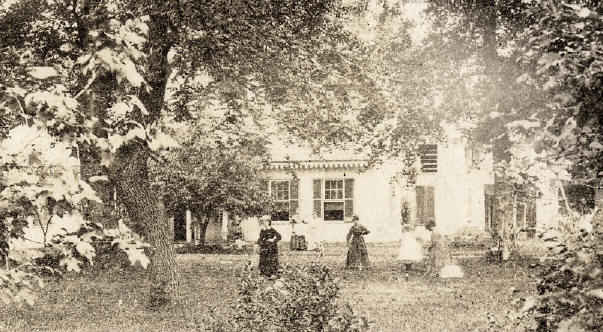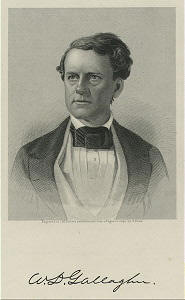Undulata
“The Haunted House of Hartwell Hollow”
“Maple Nook”

Undulata, the Pewee Valley home of American poet William Davis Gallagher,
was Annie Fellows Johnston’s model for the Haunted House of Hartwell Hollow.
This photo is from before the house fell into disrepair.
in the “Little Colonel” series. Photo from the Filson Historical Society, Louisville, Ky.
Undulata was the setting for the Halloween party put on by Aunt Allison for the children of Lloydsborough Valley in “The Little Colonel’s Holidays” In Chapter XI, Annie Fellows Johnston provides the following description of the home that became known as “the haunted house of Hartwell Hollow” to millions of her young fans:
From The Little Colonel’s Holidays (Chapter 11):
NOTHING worse than rats and spiders haunted the old house of Hartwell Hollow, but set far back from the road in a tangle of vines and cedars, it looked lonely and neglected enough to give rise to almost any report. The long unused road, winding among the rockeries from gate to house, was hidden by a rank growth of grass and mullein. From one of the trees beside it an aged grape-vine swung down its long snaky limbs, as if a bunch of giant serpents had been caught up in a writhing mass and left to dangle from tree-top to earth. Cobwebs veiled the windows, and dead leaves had drifted across the porches until they lay knee-keep in some of the corners.
As Miss Allison paused in front of the doorstep with the keys, a snake glided across her path and disappeared in one of the tangled rockeries. Both the coloured women who were with her jumped back, and one screamed.
“It won’t hurt you, Sylvia,” said Miss Allison, laughingly. “An old poet who owned this place when I was a child made pets of all the snakes, and even brought some up from the woods as he did the wild flowers. That is a perfectly harmless kind.”
“Maybe so, honey,” said old Sylvia, with a wag of her turbaned head, “but I ‘spise ’em all, I sho’ly do. It’s a bad sign to meet up wid one right on de do’step. If it wasn’t fo’ you, Miss Allison, I wouldn’t put foot in such a house. An’ I tell you p’intedly, what I says is gospel truth, if I ketch sound of a han’t, so much as even a rustlin’ on de flo’, ole Sylvia gwine out’n a windah fo’ you kin say scat!
We know from a 1907 letter that real-life Little Colonel Hattie Cochran wrote to a fan in Shelbyville and now in the Filson Historical Society’s collection that the Haunted House of Hartwell Hollow was a real place in Pewee Valley. Annie Fellows Johnston’s 1929 autobiography “Land of the Little Colonel” also noted that, “The cabin where Gay spent a summer and the Haunted House of Hartwell Hollow had also burned to the ground.” when she lamented the changes that had taken place in the valley since the time of the Little Colonel books.
Undulata was originally built by the James A. Miller family of Louisville in 1850, according to “A Place Called Pewee Valley,” published by the Pewee Valley Centennial Commission in 1970:
Beyond Rollington, in 1848, lived an artist, William C. Allan, whose hillside setting so attracted a visiting couple from Louisville, Mr. and Mrs. James A. Miller, the the following day they purchased a nearby 40-acre tract and in the spring of 1950 moved into their new log house, located on the north corner of what is now the Central Avenue-Muir Lane intersection…”This,” wrote Mr. Miller in his notebook, “constituted the nucleus and very beginning of the settlement of what is now Pewee Valley.” The Millers called their home Maple Nook.
By 1860, the U.S. Federal Census shows that poet W.D. Gallagher owned the home and was living there with his wife, Emma, and four of their children: Rebecca, Edward, Emma and Fanny. The following profile of William Davis Gallagher is from “Biographical Encyclopedia of Kentucky of Dead and Living Men of the Nineteenth Century,” published in 1877:
 “GALLAGHER, WILLIAM DAVIS, Editor, Author and Poet, was born August, 1808, in Philadelphia, Pennsylvania. His father was one of the refugees from English vengeance on account of the rebellion in Ireland, in which he was a participant. His father died when he was young, and, in 1816, his widowed mother, with her family of four sons, emigrated to Cincinnati. W.D. Gallagher spent several years on a farm near that city, and passed his Winters in a desultory way in the country school. At the age of twenty-one, he began to learn the printing business, and, while an apprentice, began his career as an author by publishing a small paper, the “Literary Gazette.” From that time, his pen was hardly ever idle, he becoming a contributing editor to many newspapers…Since 1850, when not employed under the Government or an editor, he has been engaged on his beautiful little farm, situated on the Cincinnati and Louisville Short Line Railroad, about sixteen miles from Louisville, chiefly in cultivating fruits, dreaming dreams of the life to come, and in enjoying, with philosophic resignation, his very moderate share of goods of this world…His prose writings have been extensive, covering almost every department of thought; but it is as a poet that Mr. Gallagher is most widely known. The larger part of his poetical writings have not been published, and most of his published pieces have bee “scattered to the four winds.” One of his accomplished daughters undertook, several years ago, to collect all his poetic productions for publication in a permanent form, but finally abandoned the attempt. His most considerable and, probably, most valuable poem is “Miami Woods” — commenced in 1839 and finished in 1856. Several others were quite extensive, and are divided into different parts or periods. His “Civile Bellum,” or war poems, many of them, had a wide circulation, and many of his separate pieces, as “The Laborer,” “Truth and Freedom,” “The Promise of the Present,” “A Hymn to the Day that is Dawning,” “Western Pioneers,” etc., were long ago placed among the most beautiful poems of the language; and those, with scores and scores of others of great beauty and purity, have placed their author among the first of American poets…”
“GALLAGHER, WILLIAM DAVIS, Editor, Author and Poet, was born August, 1808, in Philadelphia, Pennsylvania. His father was one of the refugees from English vengeance on account of the rebellion in Ireland, in which he was a participant. His father died when he was young, and, in 1816, his widowed mother, with her family of four sons, emigrated to Cincinnati. W.D. Gallagher spent several years on a farm near that city, and passed his Winters in a desultory way in the country school. At the age of twenty-one, he began to learn the printing business, and, while an apprentice, began his career as an author by publishing a small paper, the “Literary Gazette.” From that time, his pen was hardly ever idle, he becoming a contributing editor to many newspapers…Since 1850, when not employed under the Government or an editor, he has been engaged on his beautiful little farm, situated on the Cincinnati and Louisville Short Line Railroad, about sixteen miles from Louisville, chiefly in cultivating fruits, dreaming dreams of the life to come, and in enjoying, with philosophic resignation, his very moderate share of goods of this world…His prose writings have been extensive, covering almost every department of thought; but it is as a poet that Mr. Gallagher is most widely known. The larger part of his poetical writings have not been published, and most of his published pieces have bee “scattered to the four winds.” One of his accomplished daughters undertook, several years ago, to collect all his poetic productions for publication in a permanent form, but finally abandoned the attempt. His most considerable and, probably, most valuable poem is “Miami Woods” — commenced in 1839 and finished in 1856. Several others were quite extensive, and are divided into different parts or periods. His “Civile Bellum,” or war poems, many of them, had a wide circulation, and many of his separate pieces, as “The Laborer,” “Truth and Freedom,” “The Promise of the Present,” “A Hymn to the Day that is Dawning,” “Western Pioneers,” etc., were long ago placed among the most beautiful poems of the language; and those, with scores and scores of others of great beauty and purity, have placed their author among the first of American poets…”
A few examples of his poetry:
Stanza from “Song of the Western Pioneer”
“A song for the early times out West,
And our old green forest home,
Whose pleasant memories freshly yet
Across the bosom come!
A song for the free and gladsome life,
In those early days we led.
With teeming soil beneath our feet,
And a smiling heav’n o’erhead!
Oh, the waves of life danced merrily,
And had a joyous flow,
In the days when we were pioneers,
Fifty years ago!”
Oh, Think Not Less I Love Thee!”
“Oh, think not less I love thee,
That are paths are parted now;
For the stars that burn above thee,
Are not truer than my vow.
As the fragrance to the blossom,
As the moon unto the night,
Our love is to my bosom
Its sweetness and its light.
Oh, think not less I love thee,
That thy hand I thus resign —
In the heav’n that bends above thee,
I will claim thee yet as mine.
Though the vision of life’s morning
Ever flitted one like thee–
And thou, life’s lapse adorning,
Shalt hence that vision be.”
Poetry of the Signal Corps Association 1860-1865
“Move on the columns! Hesitate
No longer what to plan or do;
Our cause is good – our men are true –
The fight is for the Flag, the State,
The Union, and the hopes of men;
And Right will end what Wrong began,
For God the right will vindicate.”
–W. D. GALLAGHER.
“A Place Called Pewee Valley” notes that there were “numerous rockeries, and snakes, in the yard,” just as Annie Fellows Johnston describes.
By 1880, the U.S. Federal Census shows that the 71-year-old poet was widowed and living with his daughters Emma, Fanny and Jennie Cotton, as well as his granddaughter, Sally Cotton. He died in 1894 and had been in the grave seven years when “The Little Colonel’s Holidays” was written in 1901. The home’s original site, as shown on the 1879 map, is now the location of Central Place Subdivision and there is, indeed, a deep natural hollow on the property.
Even eerier from the haunted house aspect is that Gallagher didn’t escape the attention of Edgar Allen Poe, who analyzed his handwriting in the article below:
W. D. Gallagher
Mr. GALLAGHER is chiefly known as a poet. He is the author of some of our most popular songs, and has written many long pieces of high but unequal merit. He has the true spirit, and will rise into a just distinction hereafter. His manuscript tallies well with our opinion. It is a very fine one, — clear, bold, decided and picturesque. The signature above does not convey, in full force, the general character of his chirography, which is more rotund, and more decidedly placed upon the paper.
page by Donna Russell
As an interesting aside, there was another Undulata in a town in the next county (Shelbyville, Kentucky), that was owned by Harry Weissinger, the Old Colonel’s real-life brother. http://clearcreekbeagles.net/history.htm